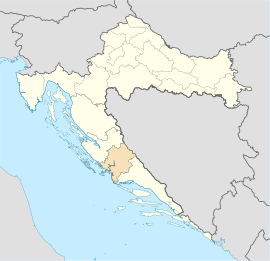Kistanje
|
Kistanje Кистање |
||
|
|
||
| Basic data | ||
|---|---|---|
| State : |
|
|
| County : |
|
|
| Area : | 244.11 km² | |
| Residents : | 3,481 (2011) | |
| Population density : | 14 inhabitants per km² | |
| Telephone code : | (+385) 022 | |
| Postal code : | 22305 | |
| License plate : | ŠI | |
| Structure and administration (status: 2013, cf. ) |
||
| Community type : | local community | |
| Mayor : | Goran Reljić ( SDSS ) | |
| Website : | ||
Kistanje ( Serbian - Cyrillic Кистање , Italian Chistagne) is a town and municipality in the Croatian Šibenik-Knin County . According to the 2011 census , Kistanje has 3,481 inhabitants, of which 62.22% are Serbs and 36.83% are Croatians.
history
In the 6th and 7th centuries AD, Croatians settled in the area of today's Kistanje. In 925 the area came to the newly founded Kingdom of Croatia under King Tomislav . In the year 1000 the Venetian fleet defeated Croatia . Kistanje (then Chistagne) as well as the rest of Dalmatia (except for Dubrovnik) came temporarily under Venetian administration.
Kistanje was first mentioned in 1401 with its current name. In 1527 a Serbian Orthodox church was built in the town and consecrated to St. Nicholas. Kistanje was the trading center of this part of the Bukovica . After the Kuridža uprising of 1704, the city was renamed Kvartir , but this was revised in the 19th century.
After the collapse of Venice in 1797 and the brief reign of France under Napoleon (1809–1813), Austria took over control of Dalmatia and thus also of Kistanje, which was assigned to the crown land of Dalmatia. In 1919, Dalmatia and with it Kistanje were integrated into the Kingdom of Serbs, Croats and Slovenes . From 1945 Kistanje belongs to the Socialist Republic of Croatia, which declared independence from the multiethnic state of Yugoslavia in 1991 and which today forms the Republic of Croatia.
In the 19th and beginning of the 20th century, Kistanje was the main town of the municipality. In the 1960s the municipality was dissolved and the Knin area was added. As an area almost exclusively inhabited by Serbs, Kistanje became part of the self-proclaimed Republic of Serbian Krajina from 1991 to 1995 . During Operation Sturm , the Serbian population of Kistanje fled to Serbia. Several war crimes have been committed in the area, such as the murder of nine elderly Serb civilians by the Croatian army in the villages of Gošić and Varivode . In 1996 the Croatian government resettled Catholic Janjevci in the abandoned houses of Serbian residents with the aim of establishing an ethnic Croat majority. Since the return of part of the Serbs, Kistanje has been a mixed city again.
population
According to the 1981 census, the population of Kistanje was 92.9% Serbs and 5.3% Yugoslavs, while the 1991 census shows 98% Serbs. Before 1995, 13 of the villages around Kistanje were only inhabited by Serbs and only Nunić had a majority of ethnic Croats.
Personalities
- Josip Giuseppe Modrić, Croatian writer from the 19th century
- Mirko Korolija (1886–1934), Croatian writer and politician
geography
Kistanje is located in northern Dalmatia . The municipality of Kistanje comprises 14 settlements:
- Kistanje
- Biovičino Selo
- Đevrske
- Gošić
- Ivoševci
- Kakanj
- Kolašac
- Krnjeuve
- Modrino Selo
- Nunic
- Parčić
- Smrdelje
- Varivode
- Zečevo
Individual evidence
- ↑ Yugoslavija | Hrvatska enciklopedija. Retrieved September 7, 2017 .
- ↑ Chris Hedges: 9 Aged Serbs Found Slain In Croat Town . New York Times. October 5, 1995. Retrieved October 8, 2012.
